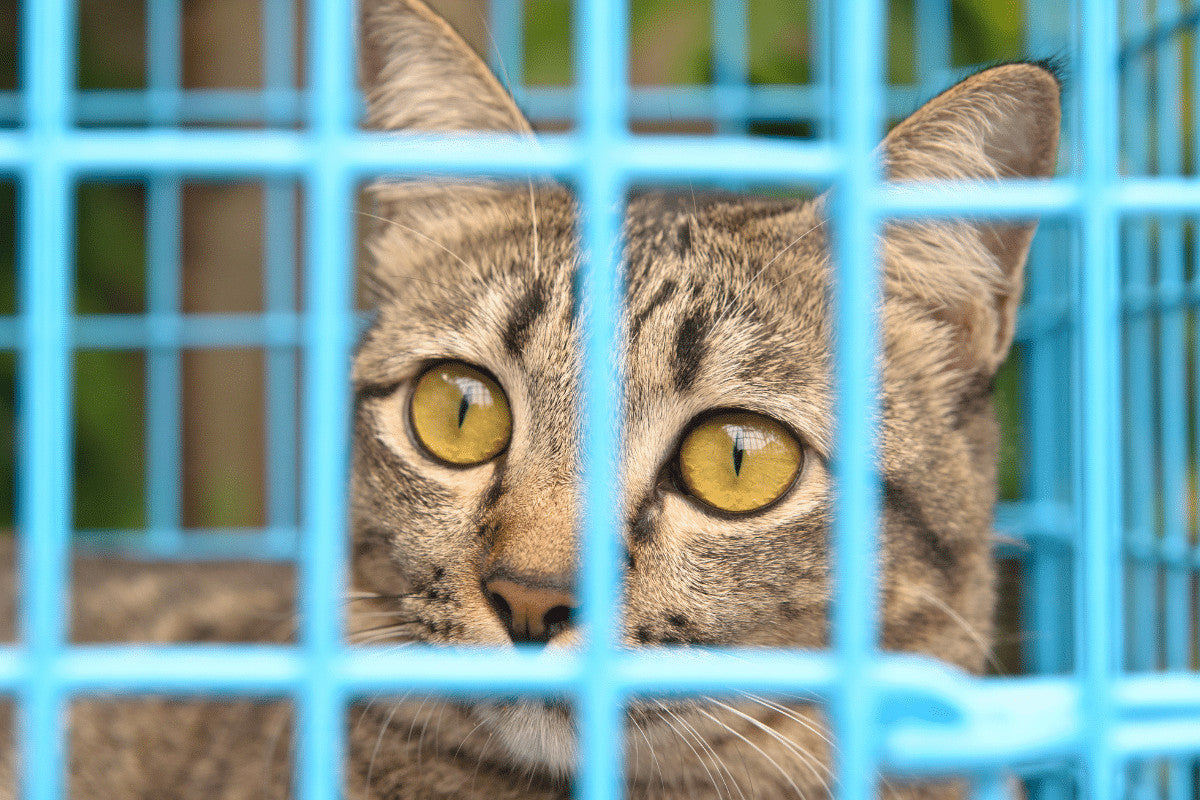Here at H&R, we have a particular soft spot for stray and feral cats. Whether we are donating money to one of our favourite animal charities during our Big Black Friday Give Back or sharing as much information as possible on how you can help homeless cats in your community.
Take a look here, here and here to see a few of our most popular articles.
Why such a focus on these animals, you ask? Well, with over nine million stray and feral cats in the UK, it is fair to say we have a very real problem. And as much as we as humans have contributed to it, the good news is we can be a part of the solution.
In this article, we discuss the best way to trap a feral or stray cat safely and humanely, what equipment you will need, how to prepare and what needs to be done once you have trapped the cat.
However, before we get to that, we need to understand what the safest and most humane way of trapping feral cats is.
What Is The Best Cat Trap?
Rescue organisations agree that the best humane cat traps are either drop traps or box traps. These resemble cages and are considered the safest way to capture stray or feral cats in your neighbourhood.
However, cats, even strays, are protected in the UK by law, so before you find yourself in a legal battle with your neighbour, you must make 100% sure that the cat in question is definitely stray or feral.
What Is Trap Neuter Return?
The only way to control feral cats' ever-increasing population is to trap, neuter, and return them. This programme also referred to as TNR, involves the humane trapping of feral cats, neutering them and then returning them to their colonies. As part of the process, the cat's left ear is clipped. This is so neutered cats can be identified quickly and easily and stops them from being trapped more than once.

Why Is TNR Necessary?
There is no getting around the fact that stray cats and feral colonies can be pests, which is why TNR is necessary. Not only does neutering prevent unwanted litters, but it also reduces these homeless cats' nuisance-like behaviour.
Because they are no longer driven by the need to breed, strays and feral cats stop marking their territory, fighting with other cats and tend to roam a lot less. Not only does their behaviour improve, but so does their health.
How To Prepare?
Now that you know why trapping feral cats is essential, let's look at how best to do it. We are not only looking at what kind of equipment you will need and how to go about planning it, but we are also giving you practical tips and essential Dos and Don'ts.
Keep in mind for 'Operation TNR' to be successful, it is going to take a fair amount of planning and preparation on your part. This includes having the correct equipment, planning ahead and knowing what should be done afterwards to care for the cats in your community.
Equipment you will need
- A humane box or drop trap
- Carriers or crates to transfer the trapped cats
- Blankets to put over the carriers
- Bait
- Camouflage for the trap
- A torch, blanket, snacks and drinks for you
Plan ahead
Anyone with experience in trapping cats will know preparation is key. And even then, it is best to expect the unexpected. To make sure you are ready, plan beforehand.
Know the law
As mentioned previously, cats are protected in the UK and considered an owner's property. Trapping and moving them to a different location is considered theft, so unless you are 100% sure the cat is feral or a stray, you could find yourself in hot water with the law.
If you are trapping cats on property other than your own, you must get permission from the necessary parties. You should also let people in the community know your plans. Two (or more) heads are better than one when it comes to trapping feral cats.
Plan ahead with a rescue centre
Depending on the colony's size, you must speak to your vet or local rescue centre beforehand. Not only do they need to be aware of any cats you will be bringing in to be neutered, but they will also need to ensure they have enough space to hold them during recovery.
If financial assistance is needed, speak to your local Cats Protection centre. They have regional campaigns where they offer neutering at reduced rates.
Research the colony
Before you start trapping, you must spend time researching the colony of feral cats. Knowing how many cats there are, whether any are injured or if there are nursing mums with kittens, will help you plan and prepare better.
Sometimes community cats will have a carer that feeds them. If this is the case, chat to them to find out what time the cats are fed and work around that. You could also arrange with whoever is feeding them to withhold food for a day. A hungry cat is more inclined to go into a trap with food.

Trapping Feral Or Stray Cats - What To Do
No matter how prepared you are and how much planning you've done, feral cats aren't always easy to trap. But don't give up. Our step-by-step guide will help you catch even the most street-wise moggy.
Make sure the trap is big enough
Keep in mind that street cats may be wary of small and enclosed spaces. Always opt for a larger trap as this is less threatening.
Consider the location of the trap
If you have observed the cats for a week or two, you will know where they are most comfortable eating and sleeping. It is a good idea to set up the traps as close to these spots as possible. Otherwise, place them in a secluded area, away from people.
Cover the trap
Using blankets or towels, cover the trap's top and sides to create a dark hiding spot. Remember not to cover the entrance.
Use leaves to camouflage the trap
If the trap looks too conspicuous, try camouflaging it with leaves, twigs and small branches. Cover the entire cage, including the trap floor, to blend in as much as possible. Do a test run beforehand to ensure your handy work doesn't impede the trap door from closing correctly.
Use the trap as a feeding station
One of the easiest ways to lure a cat into a trap is with food. Start off by placing the food at the entrance of the cage for a couple of days. Once the cat gets comfortable with this setup, you can gradually move the food further into the trap each day.
Use tasty treats as bait
We are yet to find a cat that can resist the temptation of a delicious smelling treat. If the usual food isn't working, try using tinned mackerel or salmon, chicken or even baby food in a jar.
Cover the trigger plate
Cats cotton onto things pretty quickly and will be able to work their way around the trigger plate. If this is the case, you might want to cover it with a blanket, towels or newspaper.
Another option is to cut a piece of cardboard and duct tape it to the trigger plate. However, for it to work, it needs to be slightly narrower than the trap and a few inches longer than the plate.
Spring the trap yourself
When you are trying to catch a specific cat, you could save yourself a lot of trouble and spring the trap manually. You can do this using a bottle filled with water. Simply tie a piece of string around the bottle neck, prop the trap door up with it and stand a couple of feet away. As soon as the cat you are targeting enters the cage, give the string a good yank. The bottle is released from under the door, and the cat is trapped.
Tip - You might want to practise this a few times beforehand to increase your chance of success!
Change traps
If you are not having much success with a box trap, you could try using a drop trap. Using the water bottle trick or a stick with a string tied around it, prop the trap up and wait for the unsuspecting cat to walk under it. Take note, however, this method works best if you are trying to catch one particular cat. As soon as other cats see the trap in action, they will steer clear.
Set up traps side by side
If you are trying to catch a strap-smart cat, you might want to set up two or three traps side by side, with the entrances in opposite directions. This method works well when the cat circles the trap rather than going inside. Unaware of the side-by-side trick, it may very well walk right into one of the traps on either side.
Use kittens to lure a mother cat
You could use kittens to lure a mother cat into a trap. This method will work if you have managed to capture the kittens first. Place them behind the box trap in a separate carrier. Cover the trap with towels or blankets to create a dark tunnel. Mum will think her kittens are in the trap and will go in to get them.
Use technology to trap kittens and mother cats
When it comes to trapping kittens and mother cats, you could always use your mobile phone. Find a clip with meowing kittens, then place your phone at the back of the trap. This method will attract kittens who are alone or scared or mother cats thinking it is their babies calling.
Stop Trapping
Unless you are trying to catch an injured or sick cat, you might want to consider taking a break from trapping. Trying to trap cats for an extended period will only make them warier.
What To Do Once You Have Successfully Trapped A Stray Or Feral Cat
Once you have successfully trapped the cat, you should have a plan in place. This includes making arrangements beforehand with your vet or a local rescue centre to have the cats checked over for any illnesses, as well as getting them vaccinated and neutered. Knowing what to do with them once they are ready to be returned to their neighbourhood is also important.
Keep them in a carrier
Because there is no telling what time of day you will trap a cat, there is a chance you won't be able to get it to a vet or rescue centre immediately. If this is the case, you will need to transfer it from the cage into a suitable sized carrier until you can transport it. We suggest placing the carrier up against the trap and opening the door slowly.
Make sure the carrier has blankets or towels to keep the cat comfortable, as well as food, water and a litter tray.
Tip - Don't let a feral cat loose in your home. Not only will you have a hard time catching it again, but it could also pass infectious diseases onto family members and your pets.
Returning feral cats to their community
Male cats can be neutered and released on the same day, provided they have recovered from the anaesthetic, and there are no underlying health issues. Females might need to stay at the vet or animal shelter a little longer. To maintain the cats' health, make sure there is a feeding station as well as shelter.
Trapping Stray or Feral Cats - What Not To Do
When trapping feral or stray cats, there are a few things you should never do. Carry on reading to find out how not to trap community cats for your safety and theirs.
Don't try and catch a feral cat with your hands
Remember, feral cats are not used to humans and haven't been socialised at all. Strays, on the other hand, might be a little friendlier but may still panic if you attempt to catch them with your hands. Trying to catch them this way could result in you being scratched or bitten or the cat getting hurt in its attempt to escape.

Don't use traps that are not safe and humane
Never ever try and catch a cat with any kind of equipment other than a box trap or a drop trap. These traps are the safe, humane and acceptable way to catch a cat. Any other method could seriously injure or kill a cat, and you will find yourself on the wrong side of the law.
Don't withhold food or water
While it makes sense that a hungry or thirsty cat is more likely to wander into a trap searching for food and water, we strongly recommend that you don't withhold either. Cats can become seriously ill if they go for more than 48 hours without eating and drinking.
Trapping feral cats for the first time can be somewhat intimidating, and even the best-laid plans can (and will) go wrong. If you're not sure where to start, watch this video...
<iframe width="560" height="315" src="https://www.youtube.com/embed/IarsSTLUdTw" frameborder="0" allow="accelerometer; autoplay; clipboard-write; encrypted-media; gyroscope; picture-in-picture" allowfullscreen></iframe>
If you have any experience with TNR or know of a local hero in your community, we would love to hear about them in the comments below. And don't forget to sign up for our weekly newsletter for helpful articles, special offers and members-only rewards.










2 comments
Having read through all of that, I’m struggling to understand why anyone would go to all that trouble and expense just to get rid this invasive species.
The real problem is the owners truly irresponsible attitude to pet ownership that prevails and reveals just how staggeringly selfish, blind and belligerent they are, while Tiddles is out slaughtering native species night and day causing untold damage to other people’s property and blinding small children via feces left in gardens.
Of course we will never be able to truly convey this to these selfish people, so I’m afraid Tiddles has to bare the brunt.
The real answer is for All owned cat’s to be neutered to reduce the population, and DNA samples taken so the owners can be fined for letting their animals defecate anywhere other than their own property.
Feral cats serve no purpose in the UK and the most humane form of dispatch is shooting so there is no suffering by being caught in a cage.
Can you recommend a safe trap please?